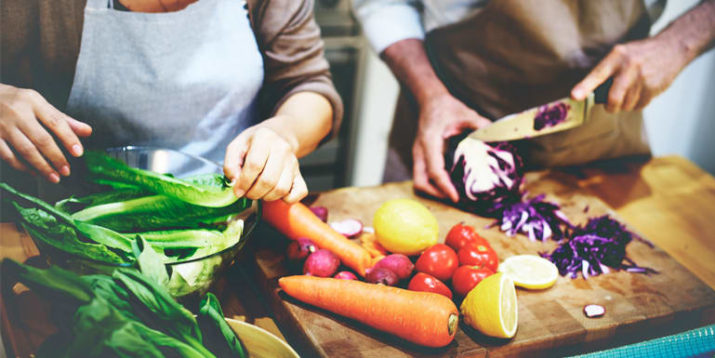Why You Shouldn’t Eat the Same Thing Every Day

Creating a healthy diet is about much more than just scarfing down a salad every day.
When I began my plan to lose the spare tire that was slowly inflating around my midsection, I thought I should just exercise consistently, eat huge salads every day, and punch them up with a little protein. I’d dutifully assemble a big bag of salad at the start of every week — romaine, cabbage, kale, grape tomatoes, red onions, cucumbers, and radishes — and shake some out for lunch each day. I’d pick a protein to chop up and toss on some sunflower seeds and light dressing on top. It was a meal packed with nutrient-dense ingredients that filled me up and made me feel like I was finally eating healthy.
And it was a healthy meal, but the thing that escaped me at the time was that becoming a healthier, stronger person didn’t revolve around shoveling the same nutritious foods into my mouth every day, just like adhering to one type of exercise or workout over and over again isn’t going to get you the physique you want. When you do the same things all the time, you plateau; you stagnate. If you want to look and feel excellent, you’ve gotta switch it up. Here’s why:
1. Eating a rainbow of fruits and veggies mean you’ll get a wide variety of nutrients
You need to have a diverse helping of whatever it is that is going to get you healthy and fit, says Torey Armul, M.S., R.D.N., C.S.S.D., national spokesperson for the Academy of Nutrition and Dietetics. “Each fruit and vegetable has a different nutrient profile, so it’s important to eat a variety of foods to benefit from the numerous vitamins and minerals.”
And an easy way to make sure you get a great and varied diet when adding fruits and veggies to your meals is to pick from a diverse color palate because those hues can also signal the types of flavonoids, or plant antioxidant compounds, they contain.
For example, yellow and orange means the plants have high levels of beta-carotene, which changes in the body to vitamin A, and may help support your immune system. Red pigments in plant foods mean that they have lycopene — thought to have antioxidant properties — and anthocyanins, linked to an array of health benefits. Bluish and purple veggies often contain ellagic acid. Getting green veggies in your diet can up your lutein and zeaxanthin consumption, both of which have been linked with supporting eye health.
2. Use the seasons as your guide.
“I recommend eating foods in season for a few reasons,” says Armul. “You’ll save money, benefit from a wide array of nutrients, and enjoy different flavors throughout the year.” Check with an online guide such as USDA’s for a general idea of which produce is popping in which month, or try the guide at Sustainable Table to find out what’s available around you and when by state and month.
Not only does picking seasonal produce ease the burden on your wallet, but it also diversifies your nutrition, and keeps your palate energized. For example, many people turn to a lot of canned, jarred, or frozen produce from December to early March so they can eat the foods they’re more familiar with but that aren’t in season. But, what if you looked at this seemingly desolate time of year as a chance to integrate new flavors in your dishes? Instead of roasting onions with winter squash as a side dish, why not replace those onions with chopped leeks? You’ll get a more mellow onion flavor, plus calcium, potassium, and folate. If you like the taste of leeks, try this recipe for Kale and Broccoli Matchstick Salad or this one for Portuguese Kale Soup.
3. It’ll help prevent you from falling into culinary rut and going off course.
A study that appeared in the Journal of Nutrition found that eating a wider variety of foods may enhance your diet and help you stick with healthy eating patterns — which will lead to better overall health. “The sign of a healthy diet is that it feels sustainable over the long term,” says Aruml. “Flexibility and variety are key to a healthy lifestyle that keeps you interested and nourished for decades to come.”
Keep your plate a constantly revolving kaleidoscope of nutrients by making small tweaks to keep the novelty alive. “If you always eat chickpeas, try black beans or lentils,” says Armul. “If you’re getting tired of Greek yogurt, try [topping plain Greek yogurt with] new flavors, or substitute with cottage cheese, kefir, or a small amount of ricotta cheese. Different herbs and spices can also add variety to your usual dishes.”
Try making a new recipe or sharing meal ideas with friends. Sometimes a look through a cookbook, browsing Beachbody Blog’s recipe library, or quick Pinterest or Yummly search for “healthy recipes” can inspire you to try something new.
I finally decided to mix up my meals, and found that alternating salads with protein bowls filled with lean meats, beans, and clean carbs such as sweet potatoes and brown rice made me feel and perform much better. And it helped me stick with eating healthy!
